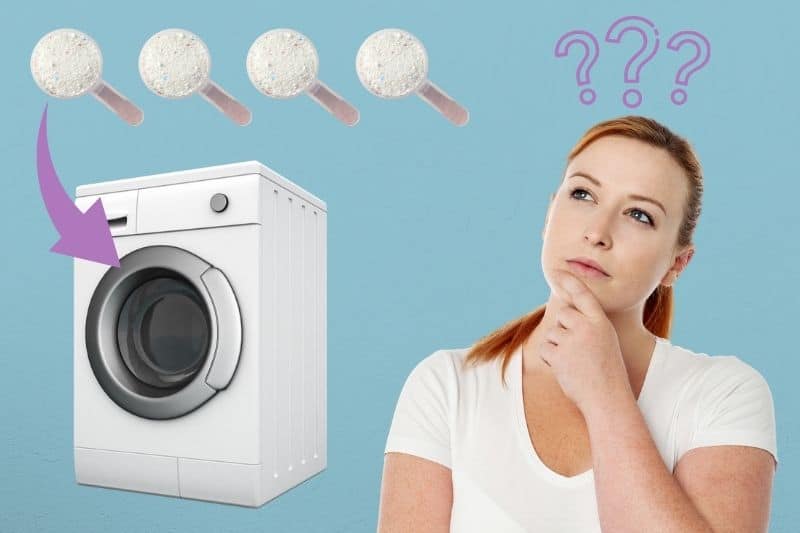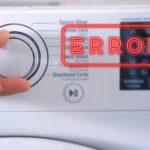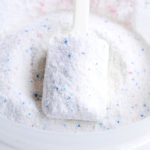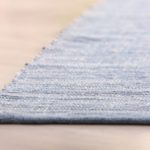If you’re new to the washing powder world you may be feeling a little confused about how much powder you’re actually supposed to use to clean your clothes!
It’s understandable why it’s so baffling – there’s so much debate about the measurements, everyone tells you different figures and perhaps you’re just used to using capsules.
But it doesn’t have to be complicated. Keep on reading to find out how much washing powder you need to use to wash your dirty clothes.
Why Is it Important to Use the Correct Dose of Washing Powder?
It’s an easy assumption to make that absolutely filthy clothes need extra washing powder to rid them of dirt, but actually, this isn’t the case.
Using too much washing powder in a washing machine may leave your clothes with little stains on them. This usually means that you’ll have to re-wash your clothes or rinse them under hot water – which is just needless and extra work!
Plus, having too much powder means more suds in the washing machine! And this typically results in a little red light on the front of the appliance flashing when there’s ‘Excess detergent’. I’ve had this problem many times!
On the other hand, not using enough washing powder will result in your clothes not coming out of the washing machine clean. So, you may need to re-wash them again!
So, as you can see, it’s vital for your clothes to be washed in the right amount of washing powder, every time!
But what’s the right amount of washing powder? Keep on reading to find out.
What’s the Right Amount of Washing Powder to Use?
Sadly, there isn’t actually one answer to this question, because every washing powder manufacturer lists different amounts on their packaging.
There are lots of different washing powder brands that you can buy today, and each and every one of them is made slightly differently, and this impacts the dose of powder you need to use when washing with that particular product.
However, there are some points to consider when measuring out your washing powder, here they are:
Check the packaging and follow the advice
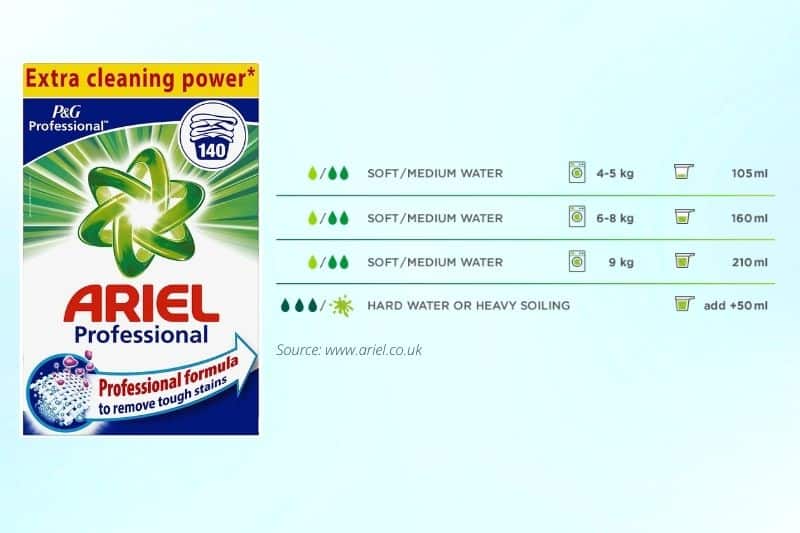
One of the easiest ways to decide how much washing powder to use is to check the label on the box and to stick to it.
For example, if you decide to use Ariel Washing Powder to wash a small to medium-sized load, and you live in a soft water area, then you need to add around 105 ml of washing powder to your machine.
If you live in a hard water area you need to add an additional 50 ml of washing powder to your washes.
These are only guidelines, of course, so you may need to adjust the amount ever so slightly depending on your particular load of laundry. And don’t forget that these figures may vary from one product to another.
Further to this, some manufacturers give out free scoops to help you scoop the right amount of washing powder into your washing machine. You should make full use of your scoop if you have one.
How big is your load of laundry?
If you decide to fill your washing machine up to its maximum capacity, then you need to put the appropriate maximum amount of washing powder into the machine.
For example, if your washing machine holds 5 kg of laundry, and you put 5 kg of clothes into it, then you need to look at your washing powder box to find out how much product to use.
If it says ‘5 kg = 110 ml’ then add this amount. If you don’t use enough washing powder in this case, your clothes probably won’t come out as clean as you’d like them to.
If you have particularly dirty clothes, you can usually add an extra 50/60 ml of powder to the washing machine. This will help to clean away the tougher dirt!
However, there will be times when you don’t actually need to fill the washing machine up.
For example, if you have a 9 kg washing machine, you may only fill it to 4 kg. So, in this case, you don’t need to use the maximum amount of washing powder to clean the clothes inside the machine.
In fact, you can adjust the washing powder amount, say to half, to improve the washing quality.
Plus, your clothes will come out powder-free!
It’s important to adjust the amount of powder you use to suit the amount of laundry you plan on cleaning.
How dirty are your clothes?
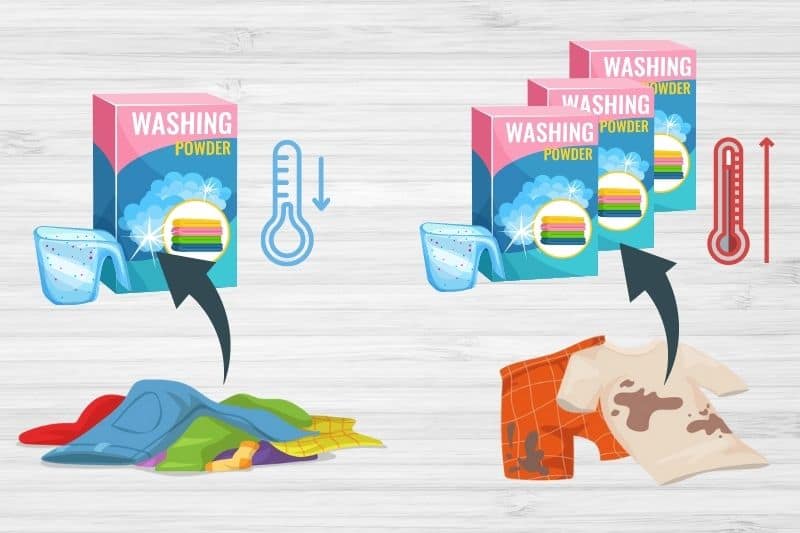
A really good indicator about how much washing powder you need to use in a washing machine is to check how grubby your clothes are.
What do I mean by this?
Typically, clothes that are relatively clean, let’s say a t-shirt that’s been worn a few times when you’ve been out and about, may not be that dirty.
So, this item doesn’t need a long hot wash, instead, it can be washed at a lower temperature and on a short cycle. And it also means that it doesn’t need a whole load of washing powder either.
In this case, you could use the minimum amount of washing powder to clean the item. And you could add similar clothes to the washing machine to spruce them up!
On the flip side, if you have dirty underwear and gym wear, for example, which is full of sweat, a longer, hotter wash with a good amount of washing powder is required. Using the right amount of powder, in this case, will make these garments hygienic for you.
As mentioned above, you can adjust the amount of washing powder you use if you’re washing a load of heavily soiled laundry.
Adjusting the portion of washing powder, you use will help to clean your clothes in the best way possible. After all, if your clothes are relatively clean, to begin with, you can save yourself some money by reducing the amount of powder you pop into the machine!
Do you live in a hard water area?
In the UK there are many homes that are supplied with hard water. While this isn’t a major problem, it is something that should be given attention to when it comes to washing clothes.
If you wash your clothes in hard water then it’s important that you follow the measurements that are written on the packaging of your chosen washing powder.
And in some cases, you may even need to add a little more powder to your washes just to make sure that your clothes come out clean.
This will ensure that enough water softeners get mixed into your clothes during the washing process.
These softeners prevent hard water mineral deposits from forming on your clothes, keep your clothes looking fresh, soften your clothes and keep the fibres in your clothes in a strong condition.
On the plus side, most branded washing powders have considered this hard water problem, so their goods contain water softeners to dampen down the hard water issue.
This also helps to reduce the build-up of limescale in your washing machine, and it keeps your appliance healthier for longer.
It’s worth pointing out that you should consider looking into limescale removers for washing machines if you don’t use washing powders, liquid detergents, or capsules that come with water softeners. This will prevent your washing machine from continuously needing repairs.
Are you planning a pre-wash cycle?
If you are planning to do a pre-wash of your clothes, then you need to factor this into the amount of washing powder you plan on using.
Usually, if you do a pre-wash you need to add an additional amount of washing powder to your machine so that you have enough powder to clean your laundry during the pre-wash and the main wash.
Not adding in the extra amount may result in the clothes not having enough washing powder during the main cycle, so they’ll end up coming out a little dull, and perhaps dirty.
Plan ahead!
The size of your washing machine
Washing machines can wash much bigger loads today, in comparison to what they could do 10/20 years ago. So, this is something worth considering when you measure out your washing powder.
If you’re still using a good old 5 kg washing machine, then you just add an amount of powder that is right for your load!
On the other hand, if you’ve got a large 9 kg washing machine in your home then you’ll probably put lots more clothes in it, so you’ll need to use a lot more washing powder.
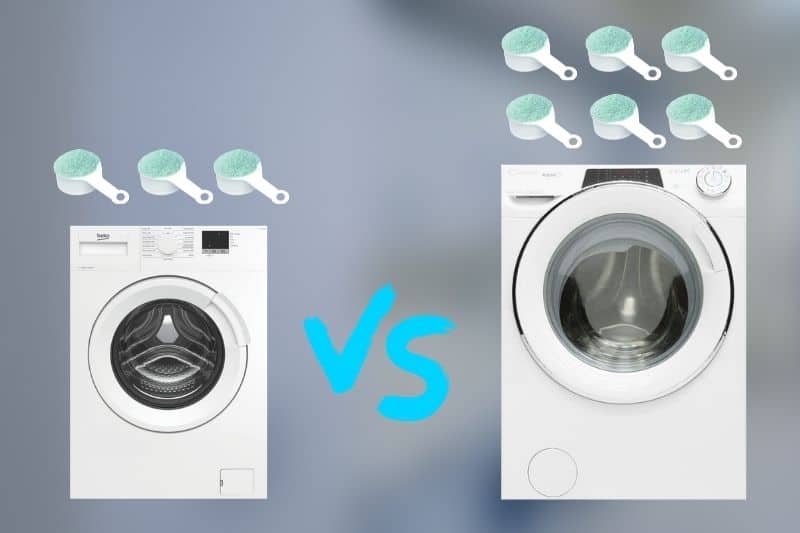
On that note… if you’ve just upgraded your washing machine from a 5 kg to a 9 kg, it’s worth remembering that you have a bigger appliance.
Because if you continue to use your old washing powder measurements, you will not necessarily have clean clothes at the end of a cycle.
Washing powder boxes are usually one step ahead on this matter, so you just need to check the measurements stated on the box and marry the figures up to your washing machine’s size.
Remember you can adjust the amount of powder you use according to the other points above too.
It’s also worth pointing out that there’s a huge difference between 5 kg and 9 kg washing machines, as obvious as this may seem. This extra 4 kg of space for laundry, will impact the amount of washing powder you go through on a weekly basis and the amount you spend on powder.
Now you’ve got a better idea about what impacts how much washing powder you use, let’s find out how you get the correct measure of powder into the washing.
Getting Your Washing Powder into Your Washing Machine
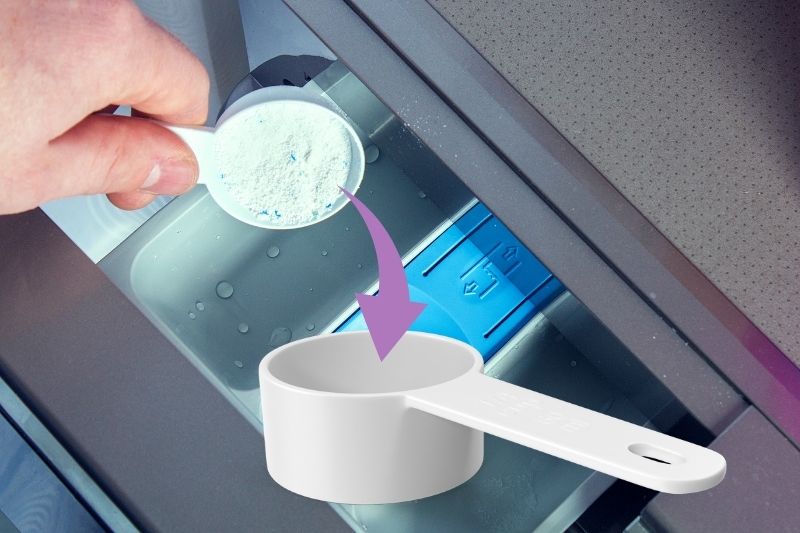
A lot of washing powder brands know how important it is for customers to use the right amount of washing powder in their washing machine.
So, with this in mind they usually give you a free measuring cup, also known as a scoop, to use to pop the powder into the machine.
These are usually made from plastic and are quite hard-wearing, so you’ll be able to use them over and over again. They also have measurements written on the side for you to read and follow.
However, there is always the chance that your little free measuring cup, or scoop, has been taken by another customer or the box just doesn’t come with one. So, what should you do if you don’t have a scoop to measure out your washing powder? Read on to find out.
What to Do if You Don’t Have a Washing Powder Scoop
A lot of companies give out free scoops to customers so that they can scoop the right amount of washing powder into their washing machine. This makes the job a lot easier! However, there are times when scoops are not handed out.
So, what should you do instead of using a washing powder scoop?
There are several ways to measure washing powder without a scoop. Here are some ideas for you. But remember, these measurements may not be exact, so you’ll have to adjust the amounts to suit your laundry loads.
1. Use a weighing scale
A really easy way to measure out your washing powder, without using a scoop, is to convert the measurement from ‘ml’ and to weigh it out in ‘grams’.
2. Buy a scoop
Yes, it’s helpful if you get stuff for free, but if you can’t get your scoop for free just buy one.
Of course, it’s a little annoying that you have to spend money, but it’s a long-term investment that could save you hundreds of pounds in the long run. Just think about how much-wasted washing powder there’d be without your scoop!
3. Check your washing machine’s drawer
A simple way to make sure you’re using the right amount of powder in your washing machine is to open the drawer where you pop the powder into. Next look in the powder drawer for a line (marker).
All you need to do is fill the drawer up with washing powder but don’t go over the line.
Not every washing machine has this marker, and sometimes the marker has worn away with years of use.
4. Tablespoon
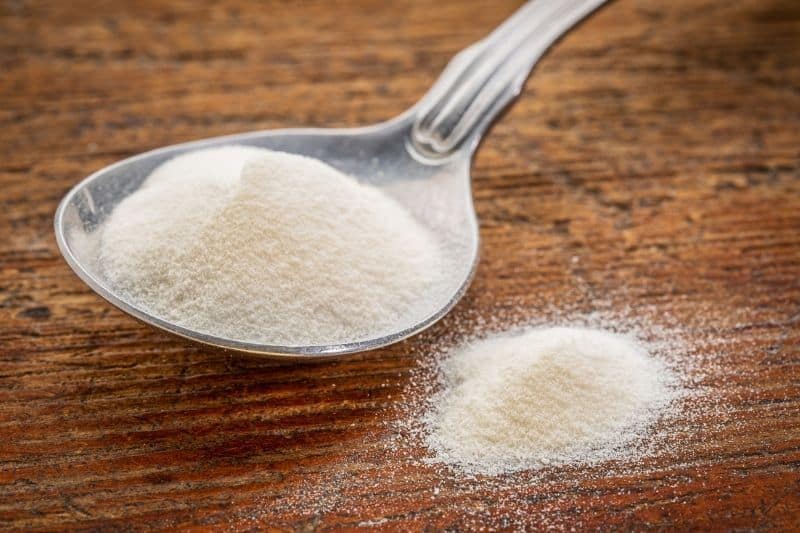
An alternative way of measuring out washing powder is to use a tablespoon.
On average, a tablespoon holds about 15 ml. So, all you need to do is just keep adding tablespoonfuls of washing powder to your washing machine until you reach the desired amount.
This is a tad time-consuming but it’s worth a go!
Make sure you clean the spoon before you use it again.
5. Use other scoops found around the home
If all else fails you can always look at what other ‘scoops’ you have lying around the house. You can check the measurements of these scoops and adjust/convert the measurements accordingly.
For example, you can use a scoop designed to make up a protein drink, or an ice cream scoop may do the job!
Always measure these ‘new’ scoops out and wash these items before you use them again!

Bethan has a passion for exploring, reading, cooking and gardening! When she’s not creating culinary delights for her family, she’s concocting potions to keep her house clean!
